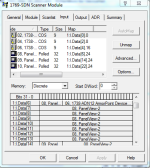Good day.
I am a newbie and I need your help, I have a project but the problem is that I have never used the panelbuilder32 and I do not know how to relate the tags of the panelbuilder32 with those of the PLC, since I have seen projects where for example the activation of a pump is I: 0/0 and in panelbuilder32 it appears as I: 54/3, I have already read many manuals and nothing takes me where I want to go and I need your help.
I am using the RSLogix 5000 for a PLC 1756-L55 Contrologix5555 with Devicenet communication for a PanelView 1000 Touch.
I hope and you can help me by showing me an example or a non-AllenBradley manual because I already read them and it does not explain how to assign the tags of each object so that the panel can send the information to the PLC.
Thank you!!
I am a newbie and I need your help, I have a project but the problem is that I have never used the panelbuilder32 and I do not know how to relate the tags of the panelbuilder32 with those of the PLC, since I have seen projects where for example the activation of a pump is I: 0/0 and in panelbuilder32 it appears as I: 54/3, I have already read many manuals and nothing takes me where I want to go and I need your help.
I am using the RSLogix 5000 for a PLC 1756-L55 Contrologix5555 with Devicenet communication for a PanelView 1000 Touch.
I hope and you can help me by showing me an example or a non-AllenBradley manual because I already read them and it does not explain how to assign the tags of each object so that the panel can send the information to the PLC.
Thank you!!








